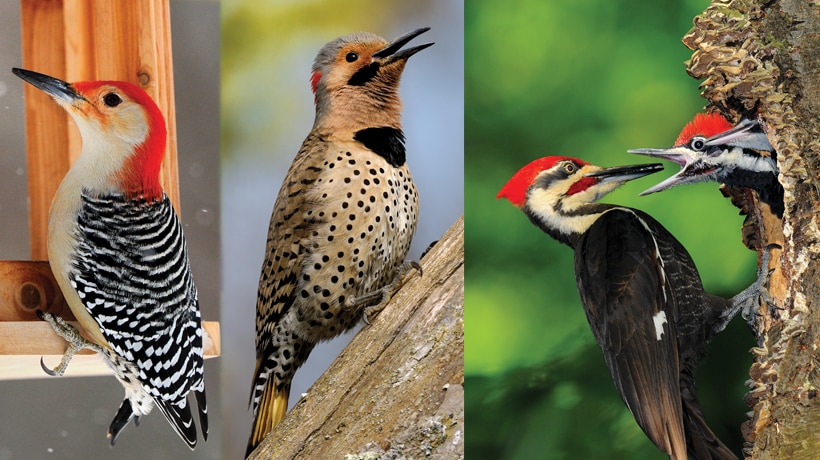Woodpeckers in Florida: Natural History, Ecology, and Preservation
Woodpeckers in Florida: Natural History, Ecology, and Preservation
Blog Article
Discover the Fascinating Globe of Woodpeckers: Every Little Thing You Need to Know
The world of woodpeckers is a world full of distinct behaviors, detailed adjustments, and a diverse selection of varieties. From their habitats and circulation patterns to their feeding routines and specialized anatomical attributes, woodpeckers have actually long captivated the passion of ornithologists and nature lovers alike. Understanding the details of these interesting birds offers a glance into the intricate interaction between their biology and the atmosphere. As we explore the globe of woodpeckers even more, we reveal a riches of details that clarifies their relevance in environments and the challenges they deal with in an ever-changing world.
Woodpecker Habitats and Distribution
In North America, for example, woodpeckers can be spotted in both coniferous and deciduous woodlands, using their solid beaks to forage for bugs and produce nesting cavities in trees. In Africa, particular woodpecker varieties have actually adapted to arid settings, such as the acacia forests, where they play a vital function in controlling insect populaces.

Feeding Behaviors and Diet Plan
Woodpeckers utilize their strong beaks to drill into the bark of trees, probing for insects and larvae concealed under the surface area. In enhancement to bugs, woodpeckers likewise take in nuts, seeds, fruits, and sap.
Woodpeckers are understood for their drumming behavior, which serves not just to connect with various other woodpeckers however also to locate food. The fast drumming audio is produced by the bird pecking on powerful surface areas like dead trees or steel posts. This habits can attract bugs concealed in the timber, permitting the woodpecker to spot their existence and feed upon them.
One-of-a-kind Adjustments for Tree Climbing
In their proficient quest of pests concealed within tree bark, woodpeckers have actually evolved exceptional physiological attributes that outfit them with unique adaptations for effective tree climbing. Woodpeckers have strong neck muscles and an one-of-a-kind skull framework that soak up the impact of constant pecking, permitting them to climb vertically without causing damage to their brains. These adaptations showcase the extraordinary transformative style that makes it possible for woodpeckers to browse trees with accuracy and effectiveness.
Diverse Woodpecker Types Worldwide
With over 200 various types spread across various habitats worldwide, the family of Picidae incorporates a remarkable variety of woodpeckers. These birds can be located in woodlands, forests, savannas, and even urban areas, showcasing their adaptability to various settings. From the famous Get More Information Northern Flicker in The United States And Canada to the vibrant and elusive Crimson-backed Flameback in Asia, each woodpecker species shows special attributes in terms of plumage, actions, and environment preference.
Woodpeckers vary greatly in dimension, with the small Downy Woodpecker measuring around 6-7 inches in size, while the effective Lineated Woodpecker can reach up to 17 inches - Woodpeckers in Florida. Their beaks also can be found in various shapes and sizes, mirroring their feeding routines. Some types specialize in removing bugs from tree bark, like the Acorn Woodpecker, while others, such as the Black-cheeked Woodpecker, feed on fruits and seeds

Conservation Efforts and Obstacles
Conservation campaigns for woodpecker populations are crucial in alleviating the influence of environment loss and various other threats facing these diverse avian species. dig this Woodpeckers face different difficulties to their survival, mostly because of logging, urbanization, environment modification, and intrusive types. To attend to these concerns, preservation initiatives concentrate on securing and bring back woodpecker environments, carrying out sustainable forestry methods, and increasing awareness about the importance of these birds in communities.
One significant challenge in woodpecker preservation is the fragmentation of their environments, causing separated populations that are more vulnerable to blog here termination - Woodpeckers in Florida. Preservationists function to produce wildlife hallways and shielded locations that connect these fragmented habitats, permitting woodpeckers to relocate between various locations for feeding, breeding, and shelter

Final Thought
In verdict, woodpeckers are remarkable birds with special adjustments for tree climbing and feeding habits. Further research and preservation activities are required to guarantee the survival of woodpeckers in the wild.
Report this page